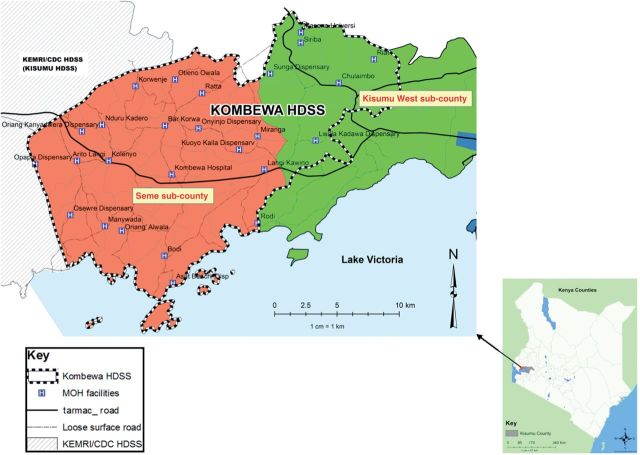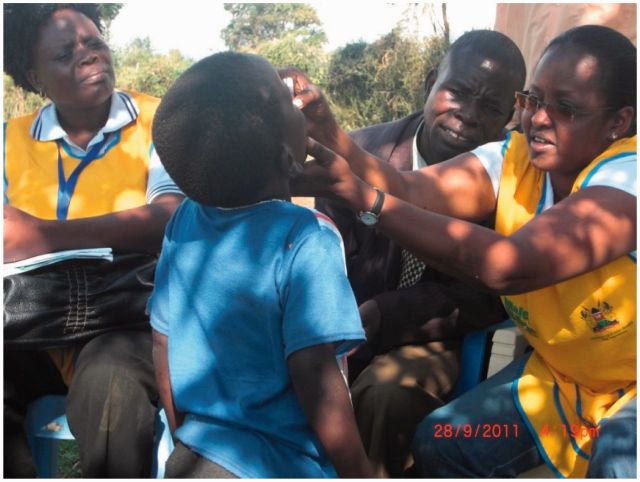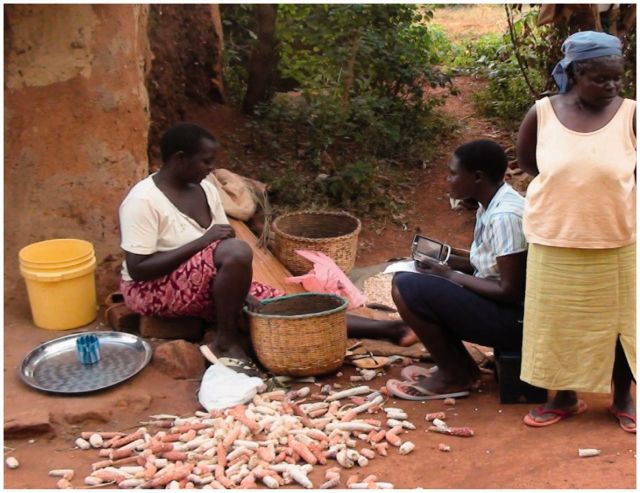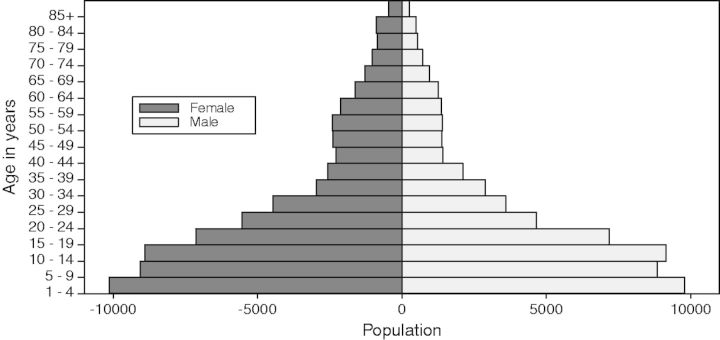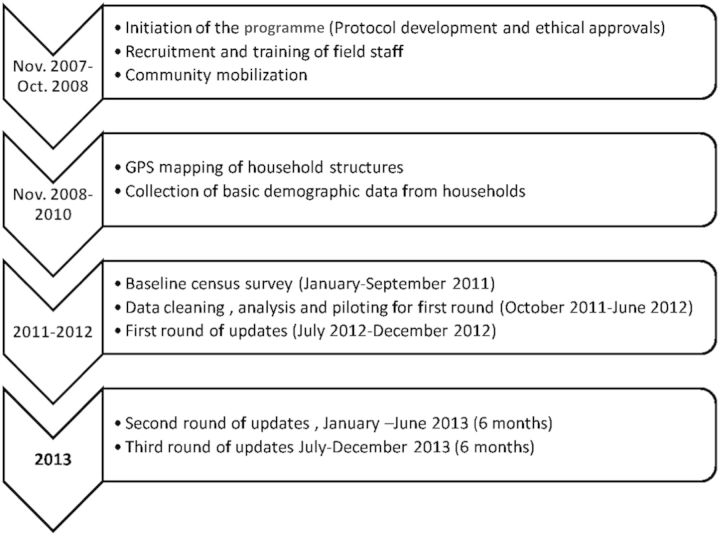Abstract
The Kombewa Health and Demographic Surveillance System (HDSS) grew out of the Kombewa Clinical Research Centre in 2007 and has since established itself as a platform for the conduct of regulated clinical trials, nested studies and local disease surveillance. The HDSS is located in a rural part of Kisumu County, Western Kenya, and covers an area of about 369 km2 along the north-eastern shores of Lake Victoria. A dynamic cohort of 141 956 individuals drawn from 34 718 households forms the HDSS surveillance population. Following a baseline survey in 2011, the HDSS continues to monitor key population changes through routine biannual household surveys. The intervening period between set-up and baseline census was used for preparatory work, in particular Global Positioning System (GPS) mapping. Routine surveys capture information on individual and households including residency, household relationships, births, deaths, migrations (in and out) and causes of morbidity (syndromic incidence and prevalence) as well as causes of death (verbal autopsy). The Kombewa HDSS platform is used to support health research activities, that is clinical trials and epidemiological studies evaluating diseases of public health importance including malaria, HIV and global emerging infectious diseases such as dengue fever. Formal data request and proposed collaborations can be submitted at Kombewadssdata@usamru-k.org.
Key Messages.
The Kombewa HDSS has established itself as a platform capable of supporting regulated clinical trials (Phase I to Phase IV) to evaluate vaccines, drugs or diagnostic platforms for a variety of pathogens found in sub-Saharan Africa.
The Kombewa HDSS has been used to support health research by generating sampling frames and developing successful recruitment and retention strategies for both paediatric and adult clinical studies.
Household morbidity data from the Kombewa DSS reveal a high burden of malaria (184 cases/1000/year) with an estimated under-five mortality ratio of 118/1000 live births for 2013.
Why was the HDSS set up?
The Kombewa HDSS was established in 2007 as a platform for the conduct of regulated clinical trials, nested studies and local disease surveillance. The HDSS is part of the Kombewa Clinical Research Centre (CRC), one of two field stations run by the United States Army Medical Research Unit-Kenya (USAMRU-K) and the Kenya Medical Research Institute (KEMRI) whose headquarters are in Nairobi. USAMRU-K has been in Kenya since 1969 and was one of KEMRI’s founding collaborators. USAMRU-K [also known as The Walter Reed Project (WRP)] is a special collaboration between the Walter Reed Army Institute of Research (WRAIR) and the Kenya Medical Research Institute (KEMRI). Historically, the site’s main focus has been the study of malaria drugs and vaccines, but as a whole WRP continues to conduct research on malaria, trypanosomiasis, leishmaniasis, entomology, HIV/AIDS, arboviruses and sexually transmitted diseases, with more than 300 manuscripts published.1
In the absence of a reliable vital registration system and given incomplete data from health facilities, the HDSS can provide a better picture of the overall health status of the population.2 The Kombewa HDSS is designed to conduct population and disease surveillance by integrating household-based and health-facility-based data, focusing on health conditions of the population.
What does it cover now?
The Kombewa HDSS, previously known as the Kisumu West HDSS, currently supports health research activities aimed at the evaluation of new interventions against major diseases of public health importance in Kenya and sub-Saharan Africa. For example, since 2009 it has been used to support the phase 3 RTS,S/AS01 malaria vaccine trial. In addition, it has been utilized as a reliable sampling frame in a household zinc fortification study and a malaria transmission intensity study. It has also been used to monitor health and demographic indicators to support planning and implementation of health programmes. During recent polio and measles outbreaks in western Kenya (2011 and 2013), the HDSS provided age-identifying information and village maps which were invaluable in the successful implementation of the ministry of health (MOH) immunization campaign.
The research centre is currently preparing to conduct a number of studies that include a baseline epidemiology study of malaria gametocyte carriage and transmission dynamics, a tuberculosis case-finding study, a surveillance study for diseases specified as adverse events of specific interest, a phase 1/2 pneumococcal vaccine trial and a HIV treatment study. The next step for Kombewa HDSS will be the establishment of a system that links hospital and field data so as to better identify clustering/patterns of various diseases in individuals presenting to the hospital (inpatient or outpatient). This information will then provide a basis for further investigation/research as well as targeted interventions. Protocols for surveillance of specific infectious diseases in the community setting (rotavirus, HIV and tuberculosis) are also being developed.
Where is the HDSS area?
The Kombewa HDSS is located in a rural part of Kisumu County, western Kenya, and covers an area of about 369 km2 stretching along the north-eastern shores of Lake Victoria (Figure 1). The demographic surveillance area (DSA) is about 40 km west of Kisumu city, the administrative capital of Kisumu County, and borders the KEMRI/CDC HDSS to the west and northern parts. The site lies between longitudes 34024’00”E and 34041’30”E, and latitudes 0011’30” to N-0011’30”S, at an average altitude of 1400 m above sea level. The area has a total of 37 subdivisions (sub-locations) and 357 villages based on mapping work done by the programme from 2008 to 2010. The Kombewa Clinical Research Centre, located at the heart of the HDSS area, is surrounded by 24 functioning health facilities, 20 of which are government and 4 private or faith-based organizations. The various health facilities are graded between levels two and three, depending on the services offered. Level-two facilities are staffed with nurses and clinical officers and offer basic curative and preventive services as well as reproductive health services. Level-three facilities are the first referral points and offer a wider range of curative and preventive services including inpatient care, laboratory services, accident and emergency services and training and technical supervision to level two.
Figure 1.
Location of Kombewa HDSS area. Under the new devolved system of government in Kenya,3 geographical political areas have been restructured and renamed and the HDSS area now encompasses all of Seme sub-county and a portion of Kisumu West sub-county. Previously, this used to cover an entire district (Kisumu West District) made up of two administrative areas (Kombewa and Maseno). The HDSS has been renamed to reflect the changes.
Who is covered by the HDSS and how often have they been followed?
The HDSS currently monitors a population of 141 956 individuals drawn from 34 718 households (2013). The HDSS population is primarily young, with a mean age of 23 years (48% of population below the age of 15). The age and sex structure (Figure 2) has a predominance of young people at the base and dearth of older age groups. The narrowing of the pyramid between ages 15-35 represents significant outmigration in this age group, often to seek educational and job opportunities available in towns and cities. A slight influx of population can be observed between ages 50-65, representing more individuals who have attained retirement age returning to the DSA. The languages spoken in the HDSS are Luo (predominant ethnic group), Kiswahili and English.
Picture 1.
A child from one of the affected Districts receiving oral polio vaccine, during a campaign by the Kenyan government following an outbreak in 2011
*Picture courtesy of the Ministry of Health, Kisumu County.
Picture 2.
A trained field worker using a handheld (Personal digital Assistant (PDA)) to interview an HDSS participant.
Figure 2.
Kombewa HDSS population pyramid, 2011(baseline).
The area is largely rural, with most residents living in villages which are a loose conglomeration of family compounds near a garden plot and grazing land. The majority of the houses are mud-walled with either grass-thatched or corrugated iron-sheet roofs. Water is sourced mainly from community wells (40%), local streams (43%) and the lake (5%) for those mostly living on the shores of Lake Victoria (baseline census 2011). Most water sources are not chlorinated. Subsistence farming, animal husbandry and fishing are the main economic activities in the area.
Malaria is holoendemic in this area, and transmission occurs throughout the year. The ‘long rainy season’ from late March to May produces intense transmission from April to August. The ‘short rainy season’ from October to December produces another, somewhat less intense transmission season from November to January. Routine demographic updates of the population are monitored twice a year. At the start of 2014, the programme incorporated a team of village reporters to boost the registration and reporting of vital events (births, deaths and pregnancy outcomes).
The baseline census (conducted in 2011) was preceded by a series of preparatory activities including a detailed GPS mapping of all household structures in the study area (Figure 3). During the mapping exercise, all mapped structures were assigned unique identifiers linked to their geographical locations. Other amenities such as roads, schools, health facilities and government offices have also been mapped.
Figure 3.
Diagram showing key activities of the programme since inception.
Different visits to update the baseline information are in place, with the rounds carried out every 6 months being the routine, core visits (Figure 4). Each household member has also been assigned a unique identifier derived from the household identifier.
Figure 4.
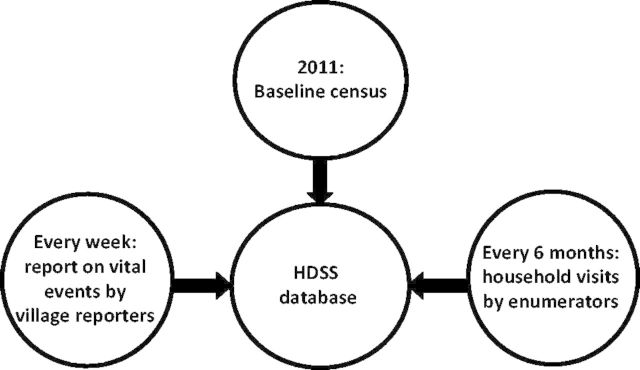
Diagram showing the mechanisms for updating demographic information.
What has been measured and how has the database been constructed?
Table 1 summarizes the variables collected among residents in the DSA during the 6-month cycle of visits. A short questionnaire on illnesses and health-seeking behaviour in the 2 weeks before each visit is included in the HDSS surveys to obtain data on prevalence of syndromes (ie. diarrhoea, fever, flu/cold, etc). The form is administered directly or via a proxy for each individual in the household.
Table 1.
Key information obtained under the Kombewa HDSS programme
| Variable | Information | Frequency |
|---|---|---|
| Compound | Latitude and longitude, unique door number numbers, compound names | Baseline, round |
| Household | Household head name, construction material (floor, roof), mosquito protection, source of drinking water, source of lighting, cooking fuel, household possessions, land tenure, garbage disposal | Round |
| Individuals | Full names, sex, date of birth, marital status, occupation, highest education level attained, relationship to household head, use of ITN the night before update | Every 2 years |
| Residents | Update on residency status (present, dead, out-migrated) update on pregnancy status of women, update on immunization status of children aged 3 years and below | Round |
| Births | Date and place of birth, names and sex of child, mother’s details (names and unique DSS Identification), father’s details (names and unique DSS Identification), vaccination status of child, estimated baby size, assistance at delivery, method of delivery, ANC attendance | Round |
| Deaths | Date of death, broad cause of death, place of death, cause of death ascertained through VA | Round, key informants |
| In-migration | Date of in-migration, type of in-migration (within or outside DSA) names, sex, date of birth of migrant, marital status, highest education level, reason for in-migration, origin of migrant, relation to household head | Round |
| Out-migration | Date and type of out-migration (in or out DSA), destination of migration episode, reason out-migration | Round |
| Pregnancy | Outcome of existing pregnancy, number of children born in lifetime, estimated date of conception, number of months pregnant, use of ITN, use of ITN the night before update, ANC attendance | Round, key informants |
| Morbidity | Malaria illness, diagnosis for malaria (by self or by medical practitioner), drug taken for malaria illness, syndromes (convulsions, diarrhoea, flu/cold, headache, fever, cough, rash, vomit, injuries, unconsciousness) health-seeking behaviour, admissions (within DSS, outside DSS, number of days admitted) | Round |
ITN, nsecticide-treated nets; DSS, Demographic Surveillance System; ANC, antenatal care, VA, verbal autopsy; DSA, Demographic Surveillance Area.
Relatives of any resident of the HDSS who dies are interviewed using standard verbal autopsy techniques in order to determine the probable cause of death. Currently, the programme is in the process of coding all verbal autopsy data from reported deaths since 2011, to assign probable cause of death and generate all-cause mortality data for the HDSS.
Data on social and economic changes within households are followed up every 2 years. Reporting and registration of vital events such as births and deaths are supported by a team of key informants stationed in each village. The Kombewa HDSS data is collected electronically using personal digital assistants (PDAs) and computer notebooks. The survey questionnaires have been preprogrammed on data collection equipment complete with user passwords and data quality control checks. The database is managed on an SQL database platform. This database, previously shown to be highly dependable in maintaining relational data, is designed in such a way that it checks for consistency before allowing data input to the system.
Key findings and publications
A summary of key demographic indices for Kombewa HDSS is presented in Table 2. The under-five mortality ratio for the HDSS is recorded at 118 deaths per 1000 live births (2013). Although still high, the recorded rate is lower compared with the national and regional averages reported in previous years.4,5 The HDSS continues to monitor progress made towards reduction of the high rates and the effectiveness of various interventions in place. The HDSS data has highlighted the gap in life expectancy at birth for females (54.6 years) and males (46.0 years) and continue to probe for possible explanations.
Table 2.
Demographic characteristics of Kombewa HDSS
| Index | Result |
|---|---|
| Total resident population | 141 956 |
| Male:female ratio | 88:100 |
| Households | 34 720 |
| Female-headed households | 44% |
| Population density (people per km2) | 388 |
| Crude birth rate (births per 1000 residents) | 12.9 |
| Crude death rate (deaths per 1000 residents) | 8.5 |
| Crude out-migration rate (no. of out-migrations per 1000 person-years) | 87.8 |
| Crude in-migration rate(no. of in-migrations per 1000 person-years) | 90.3 |
| Births per 1000 women ages 15–19 | 23.4 |
| Life expectancy at birth—female (years) | 54.1 |
| Life expectancy at birth—male (years) | 46.7 |
| Under-five mortality ratio (deaths per 1000 live births) | 118 |
All figures are mid-year averages for 2013.
Using the household morbidity data, we have estimated the prevalence of malaria in the HDSS population (184/1000/year). Individual use of insecticide-treated nets (ITNs) for protection against mosquitoes was registered at 78%. The overall household ownership of ITNs is 85% and indoor residual spraying (IRS) stands at 1.6% of HDSS households.
Regarding studies conducted in Kombewa HDSS, major findings include the first clinical trials of the RTS,S/AS01 malaria vaccine that has been found to reduce episodes of both clinical and severe malaria in children 5 to 17 months of age by approximately 50%.6 Prior work conducted at the centre to assess efficacy of various candidate vaccines marks the long journey towards development of a malaria vaccine.7–9 Another highlighted achievement is licensure of dispersible Coartem® for paediatric use following multicentre trials, with Kombewa as one of the sites.10,11 A study looking at the association between sickle cell trait and low-density parasitaemia in the HDSS area concluded that sickle cell carrier status was high (17.4%) in asymptomatic and in parasitaemic individuals living in P. falciparum malaria endemic regions, and recommended that any malaria intervention strategies should factor in the possibility of sickle cell trait as a confounder to the protective effect of the intervention.12 Participants for trials conducted at the clinical research centre prior to the completion of the baseline census were drawn from the HDSS catchment area. Attempts will be made in future to link results from these trials to the HDSS platform.
In 2012, the HDSS supported a door-to-door HIV counselling and testing initiative by the WRP PEPFAR programme in a section of the HDSS area (Kombewa division). The exercise yielded a 3.5% HIV positivity among 40 976 individuals who agreed to counselling and testing (a service acceptance of 94%). Results from the Kenya AIDS Indicator Survey (KAIS) conducted in 2012 indicate that the HIV prevalence in the region encompassing the entire HDSS is 15.6%, which is three times the nationally reported average of 5.1%.13 Researchers at the site are planning to conduct a study to gather more complete HIV prevalence and incidence data in the HDSS area in the near future. Household circumcision data generated by the programme indicate that only 42% of male adults aged 15 years and above reported being circumcised.
We interviewed household members during the routine surveys to determine causes of morbidity within the month of the interview. In 2013, a total of 33 972 cases, representing 24% of the population, reported having been ill. Children below the age of 5 years accounted for 27% of all reported illness. The most prevalent symptoms recorded in the HDSS population were fever (35%), cold/flu (20%) and cough (18%), diarrhoea and vomiting (9%) and all other symptoms and injuries at 17% and 1%, respectively. Using household survey of symptoms, we estimated the prevalence of convulsions among children under the age of 5 years (15 per 1000 children under the age of 5, per year).
Future analysis plans
We continue to analyse both morbidity and demographic data generated by the programme, to assess patterns and trends.
Strengths and weaknesses
The Kombewa HDSS has successfully supported recruitment and retention activities for several research studies nested within it, conducted at the Kombewa Clinical Research Center, including the phase 3 randomized, controlled trial of RTS,S/AS01 malaria vaccine candidate and the associated Malaria Transmission Intensity study.6 Retention rates for paediatric therapeutic and vaccine trials supported by the HDSS platform have ranged from 90 to 100% in trials ranging from 1.5 months to >4 years.
The longitudinal nature and defined population of the Kombewa HDSS provides a platform for otherwise challenging studies and public health activities such as pharmacovigilance / post-marketing surveillance and assessing impact of healthcare interventions. The programme continues to make significant contributions toward advancement of public health activities in the area by working closely with the local MOH and sharing aggregate demographic and health data to assist with healthcare allocation and planning. During recent polio and measles outbreaks in western Kenya (2011 and 2013), the HDSS provided age-identifying information and village maps which were invaluable in the successful implementation of the MOH immunization campaign. The DSS has incorporated GIS techniques into the routine data collection process, thus providing improved geographical visualization techniques, leading to faster, better and more robust understanding of disease occurrence and decision-making capabilities.
The challenge for the programme thus far has been the unique identification of the HDSS participants both at household level (during routine surveys) and at health facility level (when seeking care and treatment). Challenges with unique identification stem from the fact that most residents bear similar names within sub-tribes and that name spelling is often inconsistent. In addition, lack of a national social security numbering system or a canonical format for physical address often makes it difficult to locate and identify an individual. To improve the linkage process, the programme is developing capability to register fingerprint biometrics from the study populations as an additional unique identifier.
Data sharing and collaboration
The Kombewa HDSS is favourable to the responsible sharing of data while protecting the rights and privacy of the study participants. External partners are welcome to collaborate with the Kombewa HDSS. Identifiable data will only be shared with third parties under an approved collaboration and for ethically approved activities. A formal request for proposed collaborations should be submitted to Kombewadssdata@usamru-k.org; proposals will be reviewed and approved by the Kombewa HDSS steering committee and the institution’s Regulatory Affairs office. Basic descriptive data, maps, pictures and reports are available for download at the institution’s website (http://www.usamrukenya-deid.org).
Funding
The core activities of this programme are supported by Global Emerging Infections Surveillance and Response System (GEIS), grant number P0114_ 13_KY and P0008_ 14_KY. Additional support and funding has been provided by nested studies.
Acknowledgments
We wish to thank the HDSS community for their continued participation in this long-term project. We acknowledge the dedication by the field, data and community liaison teams in the execution of their duties. We are also grateful for the contributions made by Zewdu Woubalem and Carol Tungwony in the initial phase of this project. The Kombewa HDSS is a member of the INDEPTH Network, a consortium of member sites who conduct longitudinal health and demographic evaluations of populations in low- and middle-income countries.14 The authors acknowledge the support from the INDEPTH Network. This work is published with the permission of the Director, Kenya Medical Research Institute. Material has been reviewed by the Walter Reed Army Institute of Research. There is no objection to its presentation and/or publication. The opinions or assertions contained herein are the private views of the authors, and are not to be construed as official or as reflecting true views of the Department of the Army or the Department of Defense.
Conflict of interest: None declared.
References
- 1. USAMRU-K. USAMRU-K Public Website. 2013 [updated 2013; cited 2014 10 June]; Available from: http://www.usamrukenya.org/.
- 2.Network I. Population and Health in Developing Countries, Volume 1: Population, Health and Survival . Ottawa, ON: Indepth Network, IDRC, 2002. [Google Scholar]
- 3.Attorney General. The Constitution of Kenya, 2010. Nairobi: National Council for Law Reporting, 2010. [Google Scholar]
- 4. Kenya National Bureau of S. Kenya 2008-09: results from the demographic and health survey. Stud Fam Plann 2010;42:131–6.
- 5.Odhiambo FO, Laserson KF, Sewe M, et al. Profile: The KEMRI/CDC Health and Demographic Surveillance System—Western Kenya. Int J Epidemiol 2012;41:977–87. [DOI] [PubMed] [Google Scholar]
- 6.Agnandji ST, Lell B, Fernandes JF, et al. A phase 3 trial of RTS,S/AS01 malaria vaccine in African infants. N Engl J Med 2012;367:2284–95. [DOI] [PMC free article] [PubMed] [Google Scholar]
- 7.Otsyula N, Angov E, Bergmann-Leitner E, et al. Results from tandem Phase 1 studies evaluating the safety, reactogenicity and immunogenicity of the vaccine candidate antigen Plasmodium falciparum FVO merozoite surface protein-1 (MSP1(42)) administered intramuscularly with adjuvant system AS01. Malar J 2013;12:29. [DOI] [PMC free article] [PubMed] [Google Scholar]
- 8.Ogutu BR, Apollo OJ, McKinney D, et al. Blood stage malaria vaccine eliciting high antigen-specific antibody concentrations confers no protection to young children in Western Kenya. PLoS One 2009;4:e4708. [DOI] [PMC free article] [PubMed] [Google Scholar]
- 9.Polhemus ME, Remich SA, Ogutu BR, et al. Evaluation of RTS,S/AS02A and RTS,S/AS01B in adults in a high malaria transmission area. PLoS One 2009;4:e6465. [DOI] [PMC free article] [PubMed] [Google Scholar]
- 10.Abdulla S, Sagara I, Borrmann S, et al. Efficacy and safety of artemether-lumefantrine dispersible tablets compared with crushed commercial tablets in African infants and children with uncomplicated malaria: a randomised, single-blind, multicentre trial. Lancet 2008;372:1819–27. [DOI] [PubMed] [Google Scholar]
- 11.Abdulla S, Sagara I. Dispersible formulation of artemether/lumefantrine: specifically developed for infants and young children. Malar J 2009;8(Suppl 1):S7. [DOI] [PMC free article] [PubMed] [Google Scholar]
- 12. Otieno W, Estambale B, Aluoch JR, et al. Association between Sickle Cell Trait and Low Density Parasitaemia in a P. falciparum Malaria Holoendemic Region of Western Kenya. IJTDH. 2012;2:231–40.
- 13.Waruiru W, Kim AA, Kimanga DO, et al. The Kenya AIDS indicator survey 2012: rationale, methods, description of participants, and response rates. J Acquir Immune Defic Syndr 2014;66(Suppl 1):S3–S12. [DOI] [PMC free article] [PubMed] [Google Scholar]
- 14.Indepthnetwork. website. 2003 [updated 2014; cited 2014 13 May]; Available from: http://www.indepthnetwork.org/. [Google Scholar]



